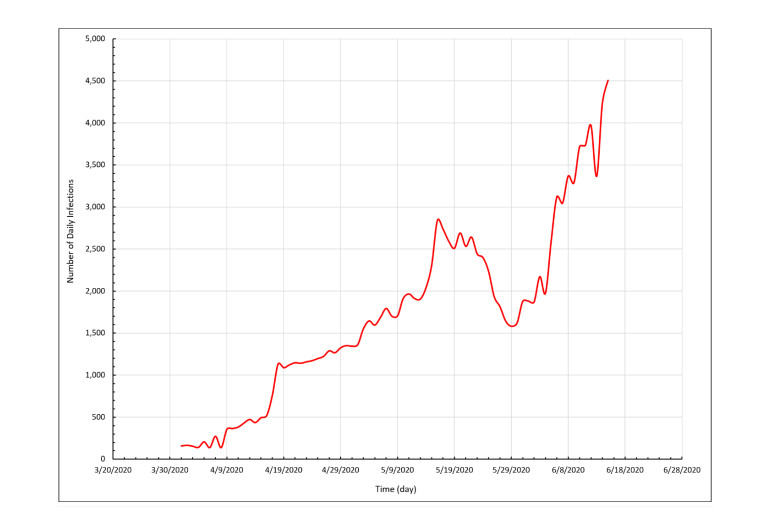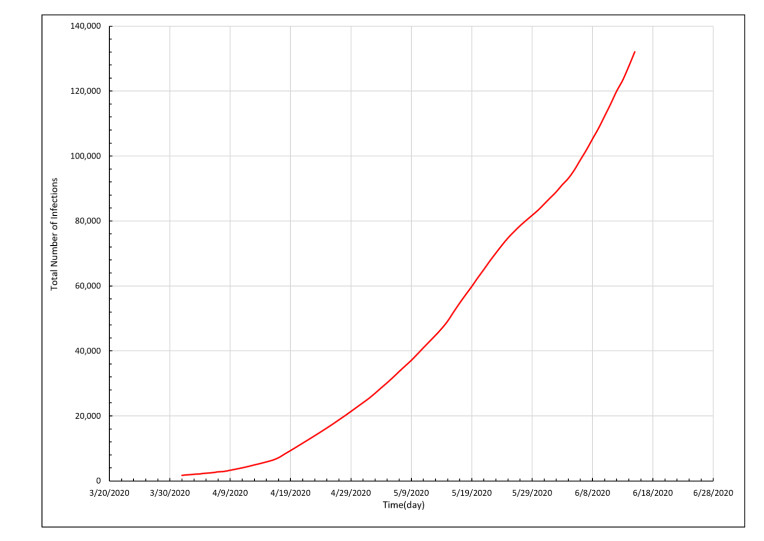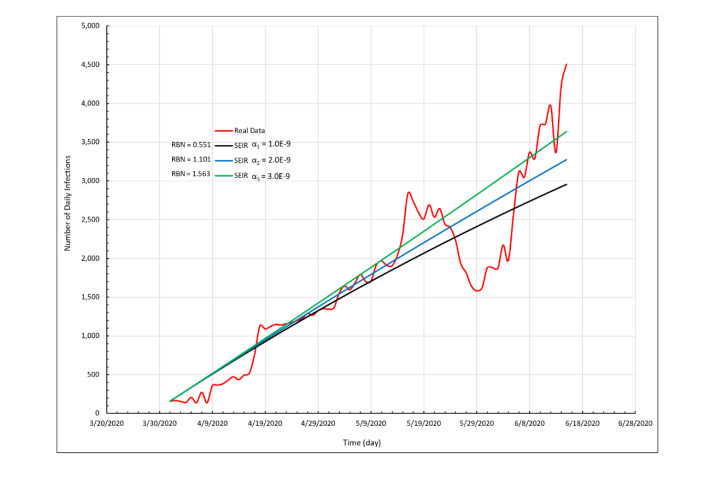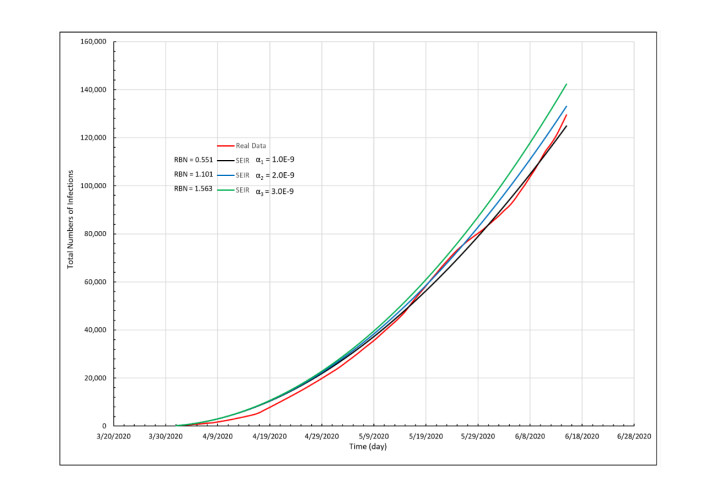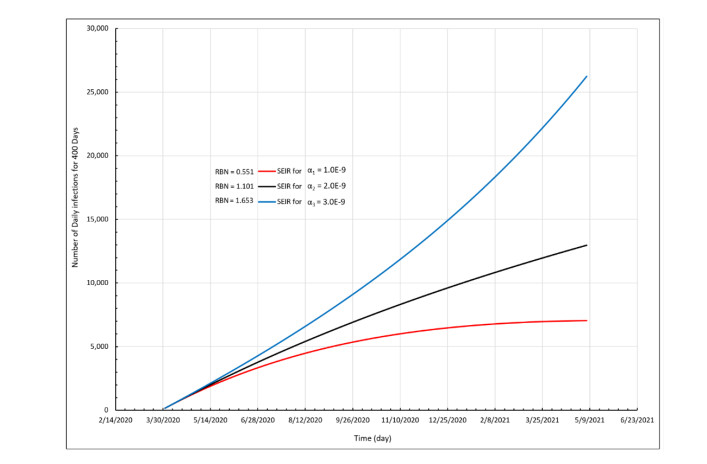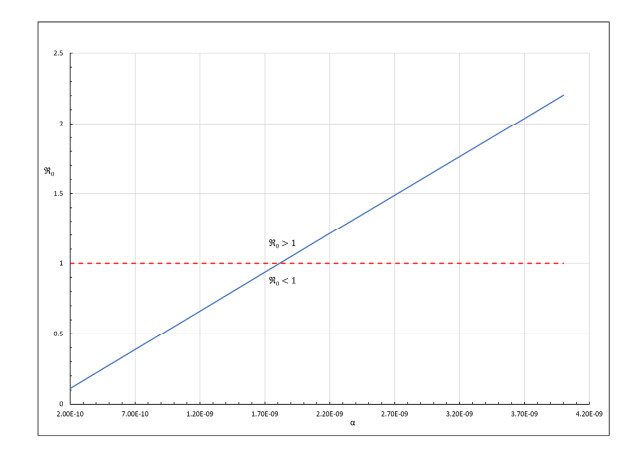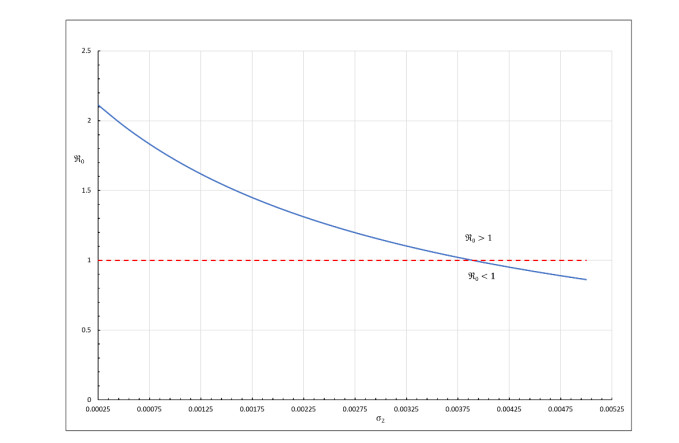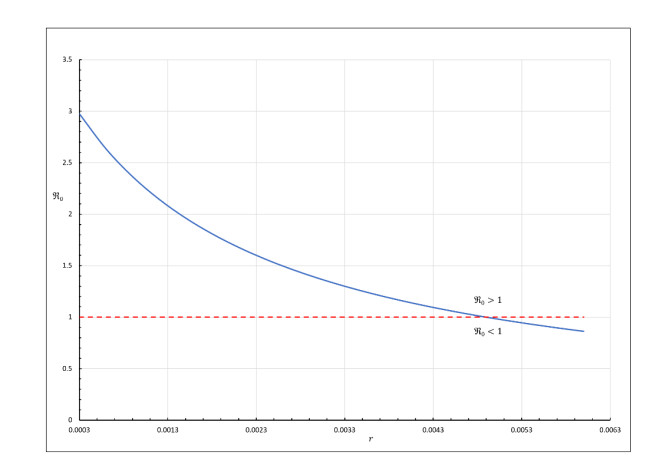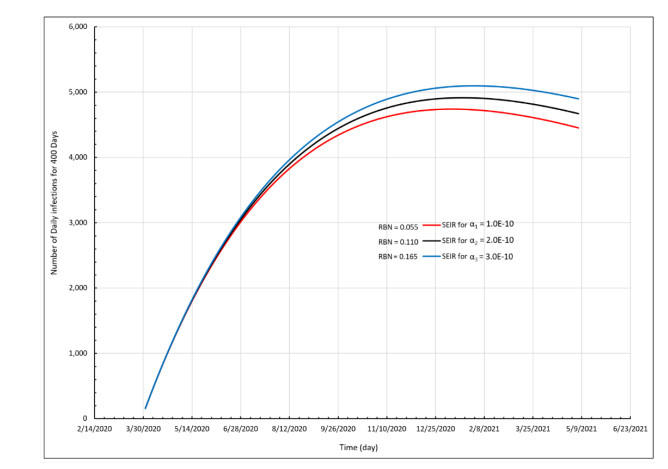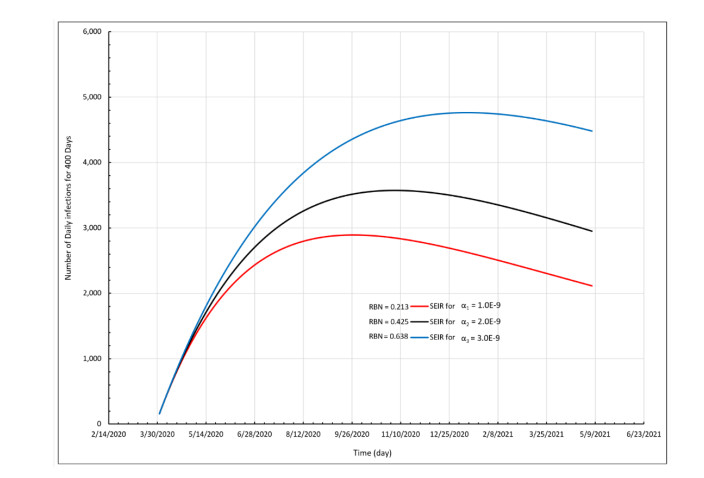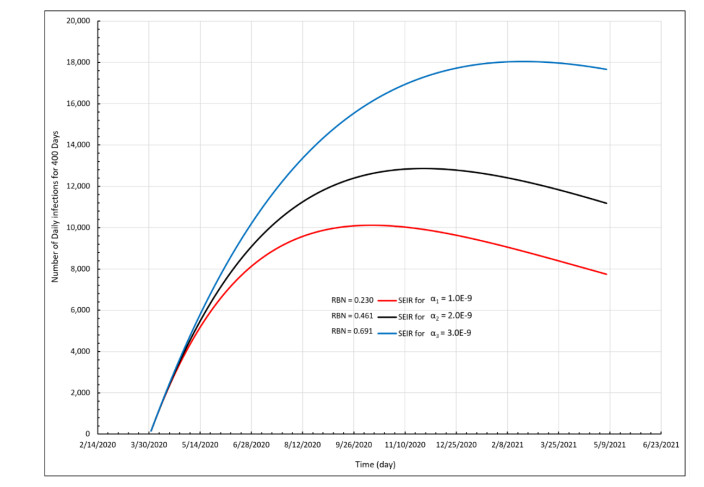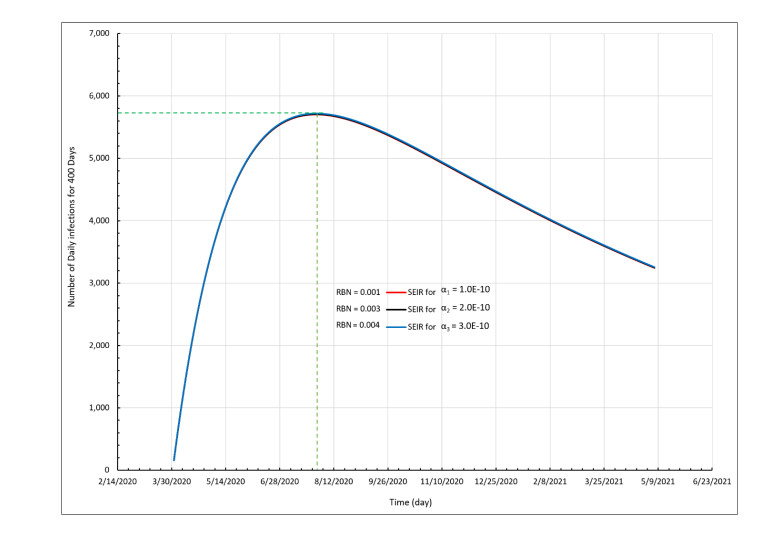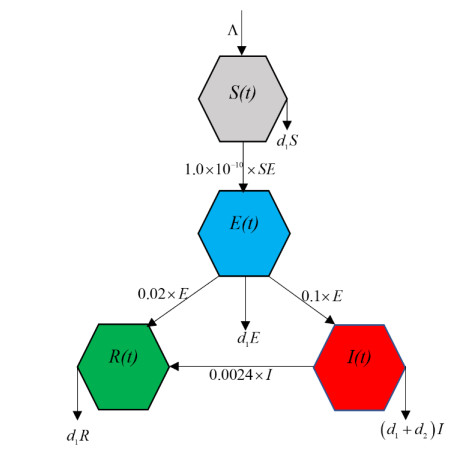1.
Introduction
One of the most global deathly diseases is HIV (Human Immunodeficiency Virus), which has its genesis from crossed kinds from chimpanzees to humans. No one knew this disease before 1980, and its transmission was not coupled with visible signs or symptoms. Almost, by 1980, HIV has spread to the five continents, also within this interval of time, more than 300,000 persons were infected by HIV. Another well-known deathly infectious disease is called Ebola. It killed many people around the world in the past years. Some scientists believed that its transmission comes from an infected animal such as non-human mammals or bats. Many other deathly diseases are existing due to the interaction between different living beings and humans. So far, humans have developed several medical protocols and techniques to protect themselves [1].
Now, all the world suffering from the COVID-19 outbreak, which is currently continuing, and the number of infections is rising steadily. This is due to the presence of many factors that increase the complexities of COVID-19 infection and create barriers to disease management. Among the most important of these barriers is the origin of the infection is still unknown, and the incubation period of the virus is entirely unlimited. Moreover, there is yet no direct treatment for this virus, or anti-vaccine. Therefore, disease control largely depends on timely diagnosis and isolation. One essential factor in the spread of this disease is the transition of infected people from one place to another, which affects more people and therefore causes the spread of this disease. As a result, many countries have prohibited air traffic for a long time, and they stopped all kinds of sports and competitions. Besides, every country around the globe is trying to reduce unnecessary travel and to reduce cases of infection in their countries [2].
Thus, scientists and researchers all over the world are trying to find out and improve vaccine or cure for the outbreak. So that in the future, such as pandemic may be controlled, from a medical engineering point framework, an infectious disease can be well known and understood by using the mathematical models. This idea was started in 1927. After that, many different mathematical models have been constructed for various diseases and infections [3,4,5,6,7,8]. Wu et al. [9] introduced the well-known SEIR model (Susceptible-Exposed-Infectious-Recovered) model to describe the transmission dynamics and estimated the national and global spread of the disease, depending on reported data from December 31, 2019, to January 28, 2020. They also estimated that the basic reproductive number for COVID-19 was about 2.68. Read et al. [10] reported a value of 3.1 for the basic reproductive number based on data fitting of the SEIR model, using an assumption of Poisson-distributed daily time increments. Tang et al. [11] proposed a deterministic compartmental model incorporating the clinical progression of the disease, the individual epidemiological status, and the involvement measures. They found that the reproductive control number could be as high as 6.47, and that involvement strategies such as condensed contact tracing followed by isolation and quarantine can effectively reduce the control reproduction number and the transmission risk. Imai et al. [12] conducted computational modeling of potential epidemic tracks to estimate the size of the disease outbreak in Wuhan, with a focus on the human to other human transmissions. Their results imply that control measures need to block well over 60% of transmission to be effective in containing the outbreak. Also, Gao et al. [13] developed a deep learning algorithm to analyze the infectivity of the novel coronavirus and predict its potential hosts. Their results indicate that bats and minks maybe two animal hosts of this virus. Most of these models have emphasized the significant role of the direct, human-to-human transmission pathway in this epidemic, as highlighted by the facts that the majority of the infected individuals did not have any contact with the marketplaces in Wuhan, that the number of infections has been rapidly increasing, and that the disease has spread to all provinces in China as well as more than 20 other countries. Many infected individuals exhibit a relatively long incubation period so that they do not show any symptoms and are unaware of their infection for as long as 10–14 days. During this time, they can easily transmit the disease to other people through direct contact. On the other hand, the models published thus far have not considered the role of the environment in the transmission of COVID-19. Several other modeling studies have already been performed for the COVID-19 epidemic [9,10,14,15,16,17,18,19,20,21,22,23].
Because the mathematical model can reach understood and definite conclusions about the COVID's outbreak, a cascade of SEIR models has been constructed and developed to describe the mechanisms of its transmission from the source of infection, reservoir, hosts to humans [22]. De la Sen, M., et al. discussed a generalized time-varying SEIR propagation disease model subject to delays which potentially involves mixed regular and impulsive vaccination rules [24]. Song et al. studied the SVEIRS infectious disease model with pulse and two-time delays. The pulse vaccination strategy is used as an effective strategy for the elimination of infectious disease [25].
Using a modified version of similar models, this paper is devoted to predicting the new COVID-19 model to be more suitable for more cases in any country by mathematical analysis of the considered model. Within this work, a proposed SEIR model has been constructed with global analysis. We aim to discover the dynamics of the transmission of the virus through humans. Another target is to study and find out the ideal protocols, control, and strategies that can reduce the outbreak significantly based on data on spreading the COVID-19 in Saudi Arabia.
2.
Materials and methods
2.1. Formulation of a new SEIR Model
During spreading COVID-19 in any country, the population could be divided into four dynamic sub-populations (see figure 1) which are described with the parameters of transmission rates as follows [1,7,17,24,26]:
● S(t) is devoted to the susceptible population who are healthy but can contract the disease.
● E(t) is dedicated to the exposed population who infected but not yet infectious.
● I(t) is dedicated to the people who confirmed infected and under treatment.
● R(t) is defined as the individuals who have recovered and cannot contract the COVID-19 again.
● α⩾0 is defined as the transmission rate from a susceptible population to infected.
● Λ>0 comprises of new birth and new residents per unit value of time
● d1⩾0 is the natural death rate.
● d2⩾0 is the death rate due to COVID-19.
● σ1⩾0 is the transmission rate of recovery from the population who confirmed infected.
● σ2⩾0 is the transmission rate of recovery from the exposed population.
● r⩾0 is the transmission rate of confirmed infected from the exposed population.
We define the total population size by N(t) as follows [1,7,26]:
According to the inflows and outflows in Figure 1, we can convert them into first-order ordinary non-linear differential equations as follows [1,7,26]:
By simplify the above equations, we have
where ε1=(d1+σ2+r) and ε2=(d1+d2+σ1).
2.2. Theorem 1 (solutions never negative)
All the solutions of the proposed SEIR model with its initial condition is a subset in the interval [0,∞) and {S(t),E(t),I(t),R(t)}⩾0 for all values 0⩽t<∞.
Proof. All the right-hand sides of the proposed SEIR model is completely continuous and locally Lipschitzian on R. The solutions {S(t),E(t),I(t),R(t)} with its initial conditions exist and are unique in the interval [0,∞) [7].
From the Eq (6) where (αE(t)+d1)=M⩾0 and Λ>0, then, we obtain the following valid inequality
By solving the above differential inequality, we get
Hence, S(t) is a non-negative function for all values t∈[0,∞).
From the Eq (7), we have
which gives
Hence, E(t) is a non-negative function for all values t∈[0,∞).
In similar manners for the rest equations, we have
and
Hence, I(t)andR(t) are non-negative functions for all values of t∈[0,∞) which complete the proof.
2.3. Theorem 2 (The solutions domain)
All the solutions of the proposed SEIR model structure that initiate in R4+ are bounded inside the region Ω defined by Ω={(S,E,I,R)∈R4+:0≤N(t)≤Λd1} as t→∞.
Proof. By differentiating both sides of the Eq (1), we get
Substituting from the proposed SEIR model (6)–(9), we get
From theorem 1, we have d2I(t)⩾0; hence, the following inequality is valid
Then, we obtain
Thus, when t→∞ we get the solution N(t)⊂[0,Λd1], which completes the proof.
2.4. The epidemic equilibrium of the proposed SEIR model
To determine the epidemic equilibrium of this model, we set all the derivatives equal to zero and solve the system as follows [7]:
which gives
From the Eq (22), we have
From the Eq (23), we have
Substitute from Eqs (25) and (26) into the Eq (21), we get
where
The number ℜ0 is called the reproduction number (RBN) [1,7].
The reproduction number is positive, and it is zero if there is no transmission, where α=0.0 and it can be interpreted as the number of secondary cases or the new infection rate.
Substitute from Eq (27) into Eq (26), we obtain
Substitute from Eqs (25), (27), and (29) into Eq (24), we get
Thus, at disease-free equilibrium (DFE) ℜ0=1 gives E=I=R=0 and leads to ε1α=Λd1, which agree with Eq (25) and the domain of solution in theorem 2.
Then, if ℜ0>1 the system has a unique endemic equilibrium [7]:
where S∗=Λd1, E∗=d1α(ℜ0−1), I∗=rd1αε2(ℜ0−1), and R∗=(rσ1+ε2σ2αε2)(ℜ0−1).
Thus, the system has a unique disease-free equilibrium E0 when ℜ0=1 and has a unique endemic equilibrium E∗0 when ℜ0>1 [7].
2.5. Equilibrium by applying Jacobian matrix
To get the reproduction number ℜ0 by using the Jacobian matrix method, we consider the disease-free equilibrium (DFE) of the proposed SEIR model is acquired by setting E=I=R=0 in the Eqs (21)–(24), hence, we obtain DFE in the form E0=(Λd1,0,0,0) [1,7].
The Jacobian matrix of the proposed SEIR model takes the following form:
By using the Jacobian's linearization method, we will linearize the first two equations considering the equilibrium situation of the system I=0,E=0,andS=Λd1.
Hence, we consider the following functions
Then, we have
By substituting from the equilibrium position, we obtain
Hence, the coupled non-linear Eqs (6) and (7) has been linearized to the forms:
and
Hence, the Jacobian matrix of the proposed SEIR model after linearization at equilibrium is given by [1,7]:
By calculating the characteristic equation given by |JE0−λI4|=0, where λ is the eigenvalues parameter and I4 is the identity matrix of order four, we obtain the eigenvalues of the matrix JE0 as follows:
Hartman–Grobman theorem state that the solutions of a square system of non-linear ordinary differential Eqs (6)–(9) in a neighborhood of a steady-state look "qualitatively" just like the solutions of the linearized system near the point E0=(Λd1,0,0,0). This result holds only when the equilibrium is a hyperbolic equilibrium; that is when none of the eigenvalues of the matrix JE0 have zero real part [7].
Thus, from (40) we obtain the following condition of equilibrium
Thus, αΛd1ε1=ℜ0<1 is the condition of equilibrium.
2.6. The uniqueness of equilibrium condition
If the matrix JE0 is obtained from the linearization and is the Jacobian evaluated at equilibrium DFE(E0)=(Λd1,0,0,0), the condition |JE0|≠0 means that the equilibrium is isolated, which means there is a disk around it that does not contain other equilibria.
Hence, from (39), we have
Thus, the condition (41) is the only condition of the equilibrium of the proposed SEIR model.
Therefore, the unique equilibrium condition of the proposed SEIR model is
and the reproduction number (RBN) ℜ0=αΛd1ε1 is also unique.
2.7. Theorem 3 (Stability analysis of disease-free equilibrium)
The proposed SEIR model DFE(E0)=(Λd1,0,0,0) is locally asymptotically stable under the condition ℜ0<1 and unstable when ℜ0>1 [7].
Proof. From the Jacobian matrix of the system (39) which is defined at DFE(E0)=(Λd1,0,0,0) and the eigenvalues (40), we have
Thus, the system is locally stable when λ4=αΛ−d1ε1d1<0, which gives αΛd1ε1<1, then, the stability condition takes the form
and the instability condition is
Thus, we have
2.8. Local sensitivity analysis of RBN (ℜ0)
Local sensitivity analysis is a sensitivity analysis that examines the change in the output values that result from a change in one input value (one-parameter). The sensitivity or elasticity of the reproduction number ℜ0 concerning any parameter p is given by [7]:
The sensitivity of ℜ0 concern p is positive if ℜ0 is increasing concerning p and negative if ℜ0 is decreasing concerning p.
Applying the formula (48) into the reproduction number ℜ0 which takes the form
Then,
The fact that ℘rℜ0=−rε1, ℘σ2ℜ0=−σ2ε1, and ℘d1ℜ0=−(d1+ε1)ε1 means that 1% increase in each one of (r,σ2,d1) will produce (rε1,σ2ε1,(d1+ε1)ε1)% decrease in ℜ0, respectively.
From relation (50) ℘αℜ0=1 means that a 1% increase α will produce a rise of 1% in ℜ0 [7].
2.9. Global stability of equilibria of the SEIR model (Lyapunov's stability theorem)
Lyapunov functions are scalar functions that may be used to prove the global stability of equilibrium. Lyapunov states that if a function V(x) is globally positively definite and radially unbounded, and its time derivative is globally negative, V(x)<0forallx≠x∗ then the equilibrium x∗ is globally stable for the autonomous system x′=f(x), and V(x) is called Lyapunov's function [7].
2.10. Theorem 4 (Global stability)
The SEIR model DFE(E0)=(Λd1,0,0,0) is globally stable of the disease-free equilibrium under the condition ℜ0<1.
Proof. We will consider the proposed SEIR model on the space of the first three variables only (S,E,I). It is clear that, if the disease-free equilibrium for the first three equations is globally stable, then R→0, and the disease-free equilibrium for the full SEIR model is globally stable.
We construct the Lyapunov function on R3+ in the following form [7]:
where κ is a parameter will be determined later, and S∗=Λd1.
The Eq (54) shows that, at the disease-free equilibrium (S∗=Λd1,0,0), V=0.
Now, we have to show that V>0 for all (S,E,I)⩾(Λd1,0,0).
The Eq (54) can be re-written as follows
The first term is positive for any value of S/S∗, and the rest two terms are also non-negative, so V>0
Now, we take the derivative of the Eq (54), we obtain
Substitute from the first three equation of the SEIR model and using the Eq (26), we obtain
We choose κ=1ε1, then we have
Since ℜ0<1 then, the last term is non-positive.
For the first term, consider d1SΛ=x, then the term inside the brackets takes the form (x+1x−2)=(x−1)2x>0, which gives two possibilities. The first one is at the equilibrium point S=S∗=Λd1, which leads to x=1. Then, the first term completely vanishes. Hence, we have the last term only, and it is non-negative. Thus, V′<0.
The second possibility is x≠1, then, the two terms are non-positive. Thus V′<0.
Therefore, V′<0 for every (S(t),E(t),I(t))⩾(Λd1,0,0).
According to Lyapunov's theorem, the disease-free equilibrium is globally asymptotically stable for the system of the proposed SEIR model in all [7].
2.11. Solutions the system of the proposed SEIR model
After linearization of the system of the SEIR model with the initial values, the system takes the form
We assume the initial conditions of the above system take the form
To solve the above system, we start to solve the equation (60) as following
where γ1=αΛ−d1ε1d1.
Then, by substitute from Eq (64) into the Eq (61), we get
By solving the above equation, we get the infection function in the form
where γ2=rE(0)γ1+ε2.
We can solve the first equation of the system by using the Eq (64)
After solving the Eq (67), we get
where γ3=Λd1(αE(0)d1+γ1−1).
By inserting the Eqs (64), (66), and (68) into the Eq (62), we can solve the ordinary differential equation R(t).
3.
Results
3.1. Numerical verification and predictions
To verify the proposed SEIR model, we will use the real data of spreading COVID-19 in Saudi Arabia. The spreading of COVID-19 has been stared in Saudi Arabia on March 3, 2020. The discovered cases continued with small numbers until the beginning of April, then the number of cases detected in infection increased. So, we decided to consider April 1, 2020, which is the real beginning of the spread of the COVID-19 epidemic in Saudi Arabia.
We used the statistics tables which issued from the Saudi Ministry of Health [27]and the daily official statement issued by the ministry as well as from the Wikipedia website [28], which also depends on the ministry's website and some other sites that would announce these statistics.
Another source of these data is the Saudi Center for Diseases Prevention and Control [29]. To obtain some information about the kingdom's population, mortality rate, and population growth rate, the official website of the General Statistics Authority of Saudi Arabia has been used.
To study the situation of spreading COVID-19 in Saudi Arabia until June 15, 2020, we will represent the curve of the daily number of infections and the time series curve of the total number of infections as in the Figures 2 and 3.
Figure 2 shows that the number of cases on April 1, 2020, was 157 infections, and it reaches 4507 infections on June 15, 2020, and between the two numbers, the curves passed through many variations up and down. Figure 3 shows that the total number of cases at the same interval started with 157 infections and reaches an accumulated amount of 132,098 infections on June 15, 2020. So, we will use this data through the proposed SEIR model to stand on whether there is a convergence between the model results and the real data [27,28,29].
3.2. Applying the proposed SEIR model to Saudi Arabia data of spreading COVID-19
According to the official data of Saudi Arabia, we have the following initial data, which is considered as the initial conditions of the system based on the SEIR model, as in Table 1 [27,28,29]:
where S(0)=34,218,169 is the total population in Saudi Arabia up-to June 15, 2020. The total number of the exposed population infected but not detected by testing has been assumed E(0)=1.5×104, while the number of infections I(0)=157. The recovery number of the population at the same time was R(0)=99.
The total number of a new birth of Saudi children and new residents Λ≈2300person/day and the rate of natural death is around 1030 persons/day which gives d1≈3×10−5. Some of the other parameters have been calculated or estimated or assumed, as in Table 2.
After using the above values of the parameter and by using MAPLE software, we get the results that indicate the number of daily infections as outcomes of the proposed SEIR model. The following figure shows the numerical results of the proposed SEIR model against the real data with different values of the parameter α and RBN (ℜ0) to stand on the convergence between them as in Figure 4. It is noted that an increase in the parameter α leads to a rise in the number of infections and RBN (ℜ0). The value of the parameter α (the rate of transmission from susceptible population to infected in Saudi Arabia) within the mentioned interval above is α=(1.0−3.0)×10−9.
Moreover, the reproduction number RBN (ℜ0) is ℜ0=(0.551−1.563)⩽1. This range gives the transmission rate at which the susceptible individual converted to an exposed individual, which means the spreading of the COVID-19 is a critical situation.
To illustrate the convergence between the results of the proposed SEIR model and the real results, we will display Figure 5, which shows the cumulatively infected numbers within the same interval referred to earlier. It is noted that the curve of the real data is setting between the three cases of the proposed SEIR model with the mention values of αandℜ0 parameters. It is pointed out that the results of the proposed SEIR model are very closed to the real results, which confirm that this model is maybe more successful than other models.
Now, we will predict the situation of spreading COVID-19 in Saudi Arabia based on the current data and parameters with the same rates without any change in the procedures. We illustrate the results of the total number of infections by applying the proposed SEIR model for the next four hundred days, starting from April 1, 2020, and end on May 5, 2021. In Figure 6, the curves and results show whether the number of infections will not breakdown, and the spreading of the COVID-19 will continue with an unstable situation or not. The curves have been done by using the same three values of the parameters α. The figure shows that the spreading of COVID-19 will continue with unstable spread without any breakdown, and the number of infections will increase.
We will show what we should do against this situation in the section of the best protocol to breakdown spreading the COVID-19.
3.3. Study the sensitivity of the RBN (ℜ0) based on the current data of Saudi Arabia
To study the sensitivity of the critical parameters against the reproduction number RBN (ℜ0), we use the Eqs (50)–(53)and represent Figures 7–9, which show the increment of the value of RBN (ℜ0) concerning the parameters α,σ2,andr. Figure 7 shows the parameter α has a significant effect on the value of the reproduction number ℜ0, where an increase of the parameter α leads to an increase in the value of the reproduction number ℜ0. The Saudi Arabia data indicates that for a stable epidemic spreading of COVID-19 ℜ0<1, the value of the parameter α must be smaller than the value 1.8×10−9, which is near to the current situation. Moreover, the Figures 8 and 9 show that the values of all the other studied parameters have significant effects on the increment of the reproduction number ℜ0. The value of each parameter which gives stable reproduction number (ℜ0<1) individually, when the other parameters are constants, is provided as follows,
4.
Discussions
4.1. How to breakdown spreading the COVID-19 in Saudi Arabia
Now, we are in the most critical section, which tells us what we should do to breakdown the spreading of COVID-19 in Saudi Arabia. Therefore, in this section, we will study the change of each parameter for the next 400 days of spreading the virus to know which one and which value will make the curve of the number of daily infections will reach the maximum value and then converts to go down.
Figure 10 shows that a reduction of the parameter α leads to a reduction in both the reproduction number ℜ0 and the number of daily infections. Figures 11 and 12 show that the parameters σ2andr have significant effects on the number of daily infections, where a decrease in the value of each one of them leads to a reduction in the value of the number of daily infections and creates a peak point situation on its curve. We did not examine the parameters d1andd2 where no one has a control to change the rates of death and that rates are out of our hands. Figure 11 represents that the peak of spreading COVID-19 in Saudi Arabia could be on February 8, 2021, if we could decrease the value of the parameter α to be in the following range α=(1.0−3.0)×10−10, which makes the reproduction number ℜ0 very small and set in the interval (0.001−0.004). Figure 12 represents that the peak of spreading COVID-19 in Saudi Arabia could be on December 25, 2020, if we could increase the value of the parameter σ2=0.02, which makes the reproduction number ℜ0<1 and setting in the interval (0.213−0.638). Figure 13 shows that the peak of spreading COVID-19 in Saudi Arabia could be on September 26, 2020, if we could increase the value of the parameter r=0.01 and α=1.0×10−9, which makes the reproduction number ℜ0=0.213.
According to the results in Figures 10–12, we can get the ideal situation of breakdown the spreading of COVID-19 in Saudi Arabia when we merge all the changes of the parameter at the same time to get the ideal case. So, we will calculate the number of daily infections based on the new values of the parameters, as in Table 3 as follows:
Figure 13 shows the number of daily infections when we apply the values of the parameters, as in Table 3, which gives us the best situation to breakdown the spreading of the COVID-19 in Saudi Arabia in the next stage. The figure represents that the daily number of infections will go down faster when we change all the parameters as in Table 3 more than changing each parameter separately. Moreover, it is clear to see that the spreading will breakdown immediately after reaching those values of the parameters, and the breakdown of spreading COVID-19 could be on July 31, 2020. Thus, by going back to the definition of each parameter, we know now what we should do to breakdown the spreading of COVID-19 in Saudi Arabia. So, we can write the best protocol, which must the population in Saudi Arabia follow it to breakdown the spread of COVID-19 in Saudi Arabia and go back to their natural life.
4.2. The ideal protocol to obtain a breakdown of spreading COVID-19 in Saudi Arabia
To get the ideal situation which can help us to the breakdown of spreading COVID-19 in Saudi Arabia, we must start implementing the following protocol and procedures (see Figure 14).
(1) They are decreasing the value of the transmission rate from the susceptible population to infected but not detected by testing the population to be α<1.8×10−9.
(2) They are increasing the value of the transmission rate from infected and detected by testing the population to the recovery zone to be σ2>0.004 by using a successful treatment and work with the principle of prevention is better than treatment.
(3) They are increasing the value of the transmission rate population r to be r>0.005, which means we have to increase the number of tests which help us to determine the population who confirmed infection and sit them in a separate zone where they are sitting with other population will increase the diseases.
5.
Conclusions
This paper proposed a new statistical SEIR epidemic for the outbreak of new COVID-19 coronaviruses. This proposed pandemic model offers a new method for evaluating and handling the COVID-19 epidemic. The real data of spreading COVID-19 in Saudi Arabia has been used to verify the results of that proposed model. The results show that the proposed SEIR model is a successful model to analyze the spreading of epidemics like COVID-19 in Saudi Arabia. The ideal protocol consists some steps, and advices have been introduced in detail to help the Saudi Arabia population to speed the breakdown spreading of COVID-19. One of the main subjects in that protocol is prevention is better than treatment. The other essential issue which helps to breakdown the spread of COVID-19 is to stay away and be at home as you can and make the infected people in an isolated zone or secured area.
Lastly, we need to increase the number of tests that confirm the infection and include effective and sufficient medication and vitamins, tonics, and supplements to protect non-infected individuals.
Acknowledgment
This work was funded by Research and Development Grants Program for National Research Institutions and Centers (GRANTS), Target Research Program, Infectious Diseases Research Grant Program, King Abdulaziz City for Science and Technology (KACST), Kingdom of Saudi Arabia, [grant number (5-20-01-007-0002)]. The authors are very grateful and thank the Research and Development Grants Program for National Research Institutions and Centers (GRANTS), Target Research Program, Infectious Diseases Research Grant Program, King Abdulaziz City for Science and Technology (KACST), Kingdom of Saudi Arabia, to fund this project and this work.
Conflict of interest
The Authors declare that this work has no conflict of interest.
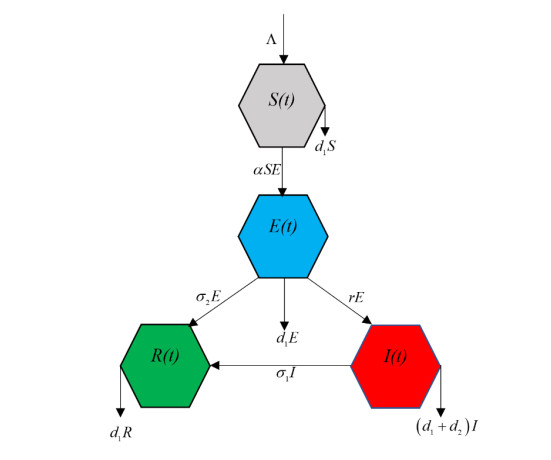









 DownLoad:
DownLoad:
